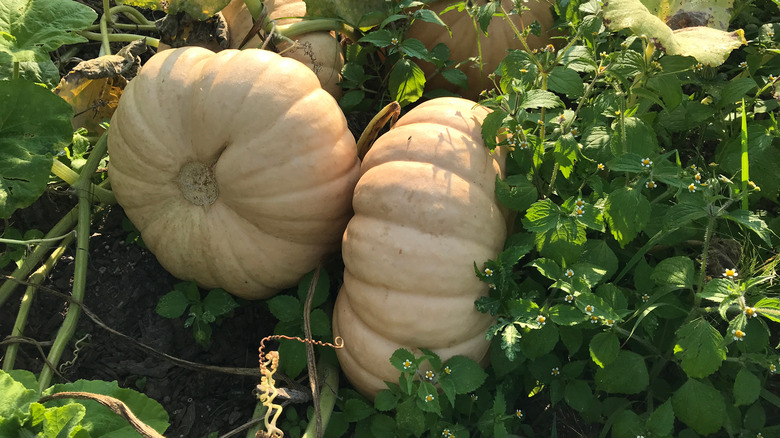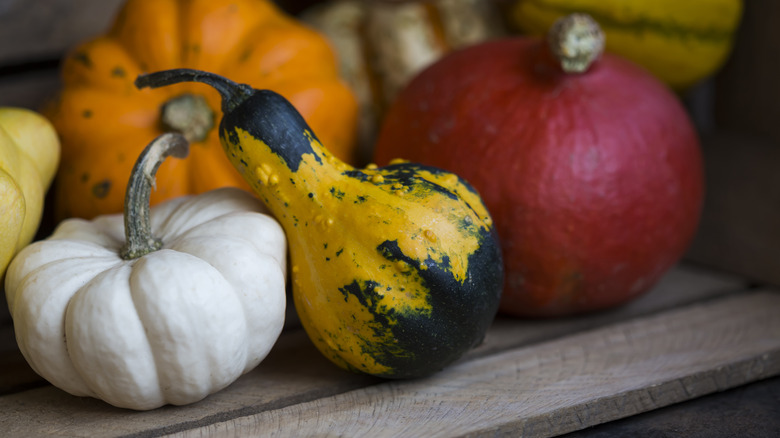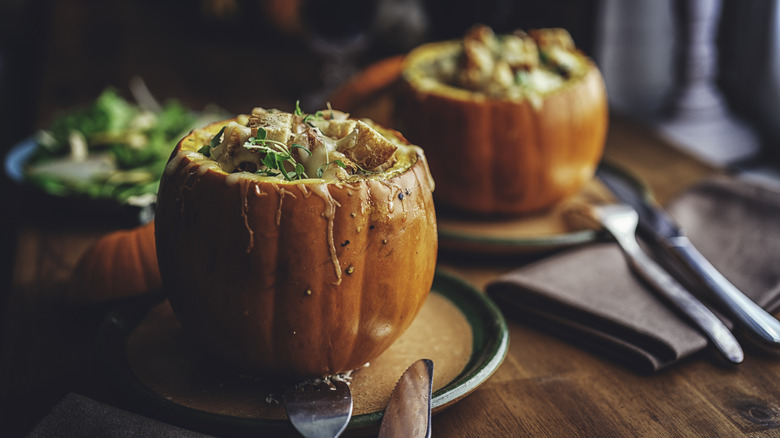The Unique Pumpkin Variety That Dates Back To The 19th Century
Pumpkins originated in the Americas — Mexico, to be exact. Historic records suggest that people have cultivated them for nearly 10,000 years, but the Long Island cheese pumpkin is a relative newcomer to the squash world. Indeed, it's only been around since about the 1850s or 1860s.
Fans of this heirloom squash might find procuring its seeds to be a tricky bit of business at times. Native to New York, the Long Island cheese pumpkin nearly went the way of the dodo in the 1960s, despite being only a couple of hundred years old. Blame this on the prevailing culture at the time. Post-war mass production made thin-skinned, pop art-colored pumpkins from the Heartland the more popular choice when it came time to can orange squash for Thanksgiving pie recipes. The flat, ochre-hued Long Island variety just didn't make the grade. It wasn't bright enough nor smooth enough.
Nowadays, thanks to the efforts of Ken Ettlinger, a Suffolk County College professor and seed saver, the cheese pumpkin is getting a second shot at an extended life. Ettlinger noticed that his favorite pie pumpkin got increasingly difficult to find. Growers had difficulty cultivating them because the seeds weren't a favorite among seed sellers, and no seeds equals no pies. With the help of Curtis Sylvestor Showell, a man known for seed breeding in Maryland, the professor managed to make the cheese pumpkin viable again on the market.
Characteristics of the Long Island cheese pumpkin
Ironically, the tough skin — the quality that made the Long Island cheese pumpkin less attractive to food canneries — likely made it more popular with the early American farmers that cultivated it in the 19th century. Although commercial refrigeration dates back to the 1850s, most people didn't keep an actual refrigerator in their home until around 1930.
Fortunately, unlike summer squash, which boasts a thin skin and an equally minuscule shelf life, the Long Island cheese pumpkin lands solidly in the thick-skinned, winter squash category. Those are pumpkins that come to harvest between late August and the end of October. Because of this, refrigeration may not be necessary for this winter squash. If it's kept in a cool, dark place — like a root cellar, for example — it lasts 90 to 100 days. The longest-lasting ones go the distance: They're good for up to six months.
Its heavily ribbed appearance and relatively flat shape, as far these fruits go, has earned it a place in the Cinderella pumpkin category. It's small size — 6 to 10 pounds — takes it off the table as a serious contender for carriage-with-six-horses status. However, were it possible to grow a 2,000-pound pumpkin from one of its seeds, its tough, nearly nutshell-like exterior would make for a solid carriage cab. It's also the pumpkin's appearance that gives it its name — it looks like a flat round of cheese, though its taste is about as far from a tangy orange cheddar as you can get.
Using them in recipes
Long Island cheese pumpkins began finding their way into recipe books and almanacs during the 1800s, and they're more readily available today than they were in the 1960s. The cheese pumpkins' ribby, cute appearance have made them more of a prize for ornamental pumpkin collectors than for cooks, though they're appropriate for both uses. Its interior is smoother and less stringy than its other squashy counterparts, making it a solid choice for creamy, savory dishes. Think stuffed pumpkin or pumpkin soup (particularly if the dish is seasoned with Chinese five-spice).
The Long Island cheese pumpkin is also a close relative of the butternut squash, and home gourmands can swap them in recipes as they wish. Naturally, it's a shoo-in as a pie pumpkin thanks to its native sweetness, though some prep is in order. You first need to cut it up into quarters and bake it for about 90 minutes to soften it up. It'll lose its Cinderella-pumpkin look, but from a flavor perspective, it'll be magical enough to tickle the taste buds of even the most discerning Fairy Godbaker amongst you.


